Achieve product-market fit with a data-led approach
Make a lead conversion process as predictable and scalable as possible

Reach product-market fit faster using data
Are you looking to achieve product-market fit, or make the lead gen or lead conversion process as predictable and scalable as possible?
You’ve already done your homework about your addressable market, you’ve carried out qualitative customer research, and you’ve got an MVP, but you’re still unsure of what to focus on to generate more leads or sign-ups?
Then this guide will be useful to you. We’ll show you how to use data to help you:
- Focus on the best performing channels,
- Measure the impact of your website in generating interest, or
- Decide which area of your customer journey to focus on next.
You may have issues with dev resources (or resources in general), you may lack team alignment, or you may find it hard to decide which segments to target or which channels to advertise on.
This guide will help you tackle your objectives regardless of the constraints you have – if anything, you’ll get clarity on what you need to focus on, and it will be easier to solve those pain points, too.
What framework do we apply to solve these issues?
We use product analytics pre-built reports from InnerTrends.
The insights derived from the reports will guide you in your quest. Read on.
Identify the best performing marketing channels
First, check out the InnerTrends pre-built report: What traffic sources drive visitors to reach a specific goal (in this example, Onboarding)?

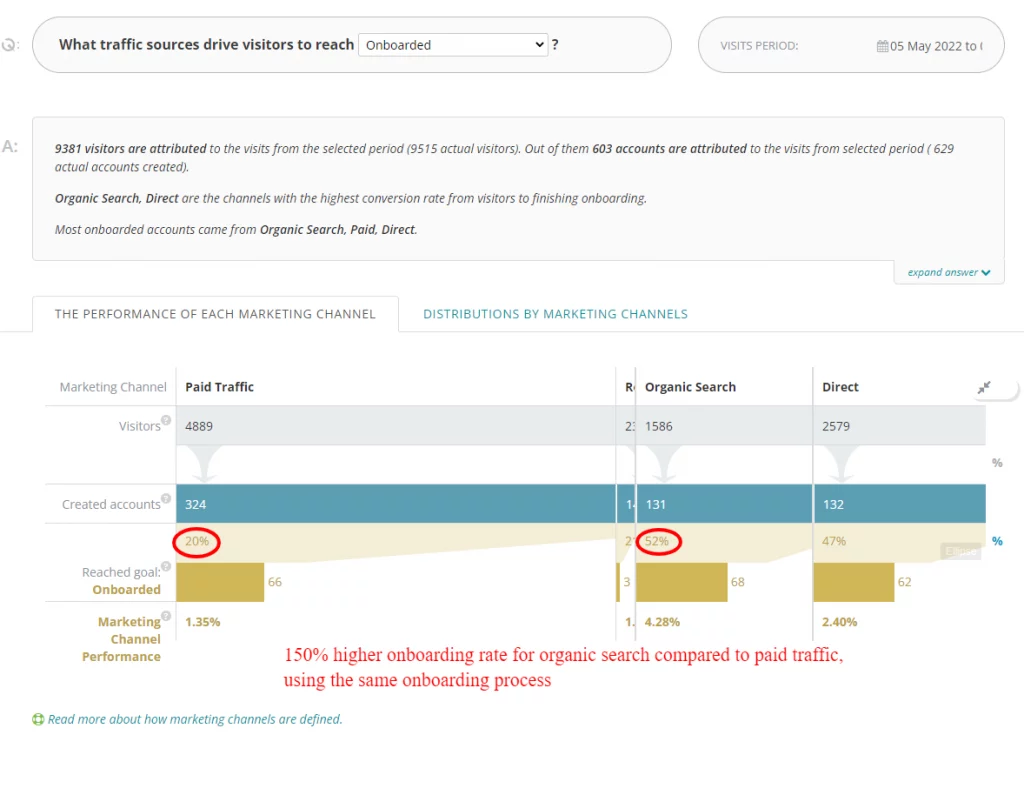
What insight(s) you’ll get: The marketing channels are most likely to drive higher quality sign-ups in your product.
The report also offers a distribution of the marketing channels that are most successful in driving traffic.
Outcome:
- Avoid investing budgets, resources, and time in underperforming channels.
- Hit your new sign-ups target without increasing your ad budget.
Account-based marketing attribution
The report is account-based: once an account is created, we’re able to attribute performance to the original campaign regardless of devices, if a different user from the same account reaches the goal, or if cookies are deleted or blocked.

Cleaned & relevant data by default
InnerTrends cleans your traffic data automatically, removing the traffic from existing users or unqualified visitors by default, and applying marketing attribution automatically.
Measure the impact of your homepage in driving interest in your product
Your homepage is the best place to display your messaging and positioning. By analyzing the audience that discovers your website through the homepage you can get a good sense of how clear and effective your current positioning is for the targeted audience.
What pre-built InnerTrends report you need to look at: What is the performance of a marketing channel? (Define a channel as: All the visitors with landing page: Homepage.)

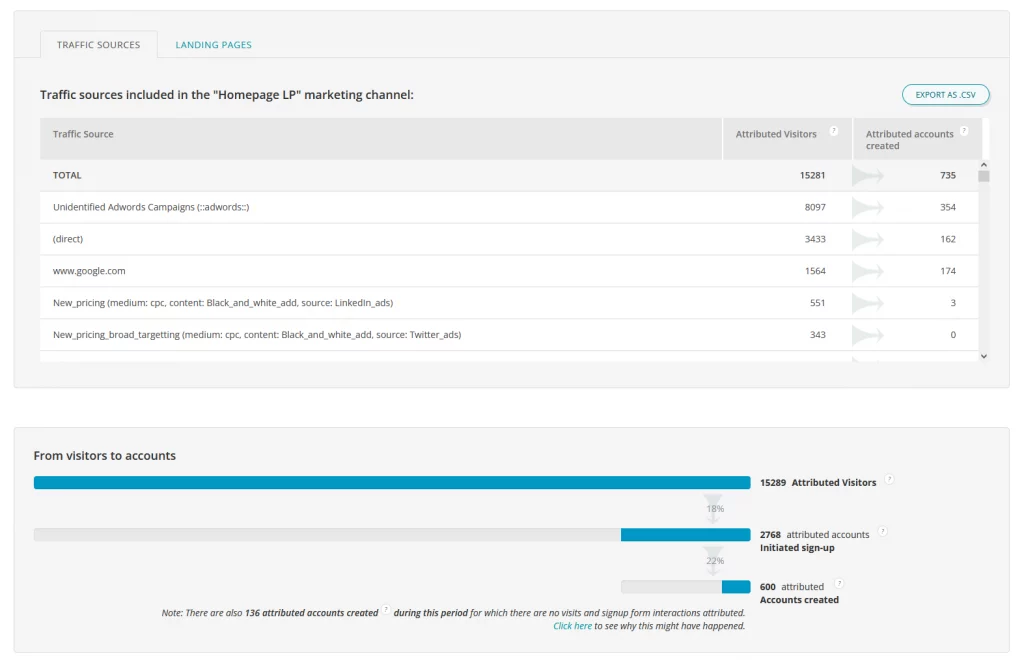
What insight(s) you’ll get: The percentage of homepage visitors that show sign-up intent, or, in other words, the conversion rate from visitors to sign-up intent. The report also shows you the conversion rate from sign-up intent to accounts created.
The signup intent conversion rate is a great indicator of how well your messaging and positioning are catering to your targeted audience needs.
What is sign-up intent: Visitors checking your pricing, clicking on or requesting a demo or a live tour. Checking the registration process to see what information is required of them in order to create an account is also part of sign-up intent.
Measuring it is critical for guiding the optimization of your acquisition strategy.
Outcome: You’ll know which area needs optimizing. Here’s how you should interpret results:
 VISITOR -> SIGN-UP INTENT
VISITOR -> SIGN-UP INTENT
For freemium businesses, a low level of accounts created from those that show signup intent (under 20%) usually indicates that there’s not enough information on the website to convince people it’s worth sharing their data to get access to your service.
Ideally, for this step, you should be at over 50% (for B2B SaaS).
The same exercise can be applied to investigate any other landing page where you’re experimenting with different messaging or to create marketing channels based on specific ads you’re running to test out your messaging.
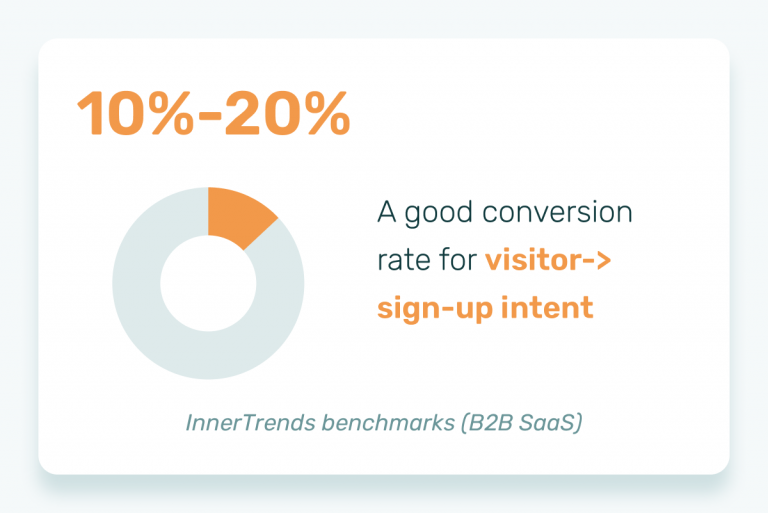
 SIGN-UP INTENT -> ACCOUNT CREATED
SIGN-UP INTENT -> ACCOUNT CREATED
For freemium businesses, a low level of accounts created from those that show signup intent (under 20%) usually indicates that there’s not enough information on the website to convince people it’s worth sharing their data to get access to your service.
Ideally, for this step, you should be at over 50% (for B2B SaaS).
The same exercise can be applied to investigate any other landing page where you’re experimenting with different messaging or to create marketing channels based on specific ads you’re running to test out your messaging.
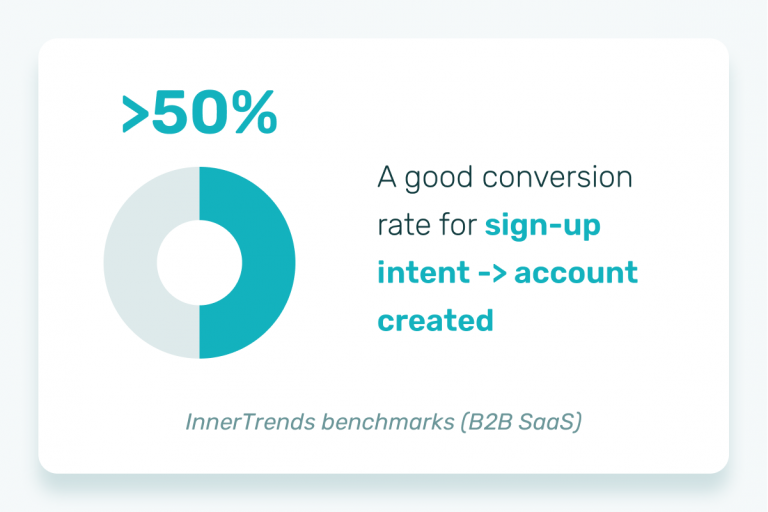
Measure the impact of the pricing page on the decision to sign up
The pricing page can be a blocker or an accelerator for getting people to sign up for your product.
What pre-built InnerTrends report you need to look at: What is the conversion of my signup process? (Note: viewing the pricing page needs to be defined as part of your sign-up actions).

What insight(s) you’ll get: You’ll see the impact the pricing page has on getting people to sign up.
Outcome: You’ll know if you need to change your pricing page – or something else. If the pricing page is problematic, you’ll need to dive deeper to see if you have a packaging issue, a display issue, and so on.
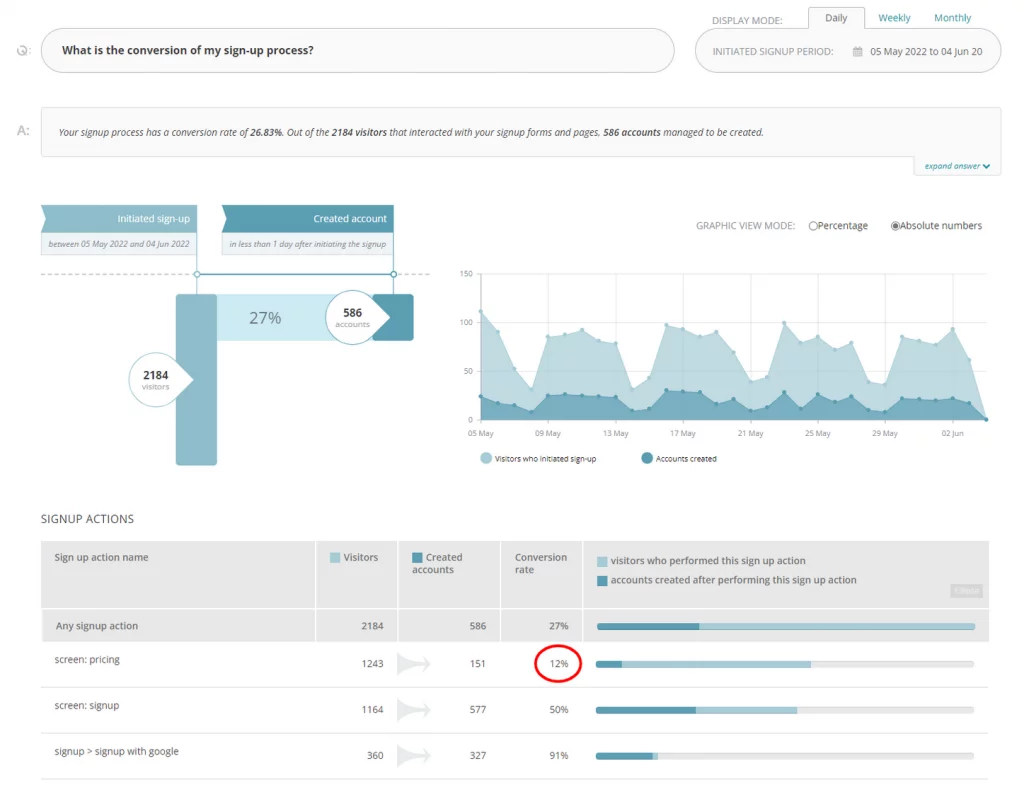
Test different landing pages until you significantly improve your metrics
Some landing pages do a better job than others at driving MQLs (marketing qualified leads) or PQLs (product qualified leads). Regardless of your approach – product-led or sales-led, or a combination of the two, it’s important to understand which pages perform better.
What pre-built InnerTrends report you need to look at: What landing pages drive visitors to onboard or reach a specific goal?

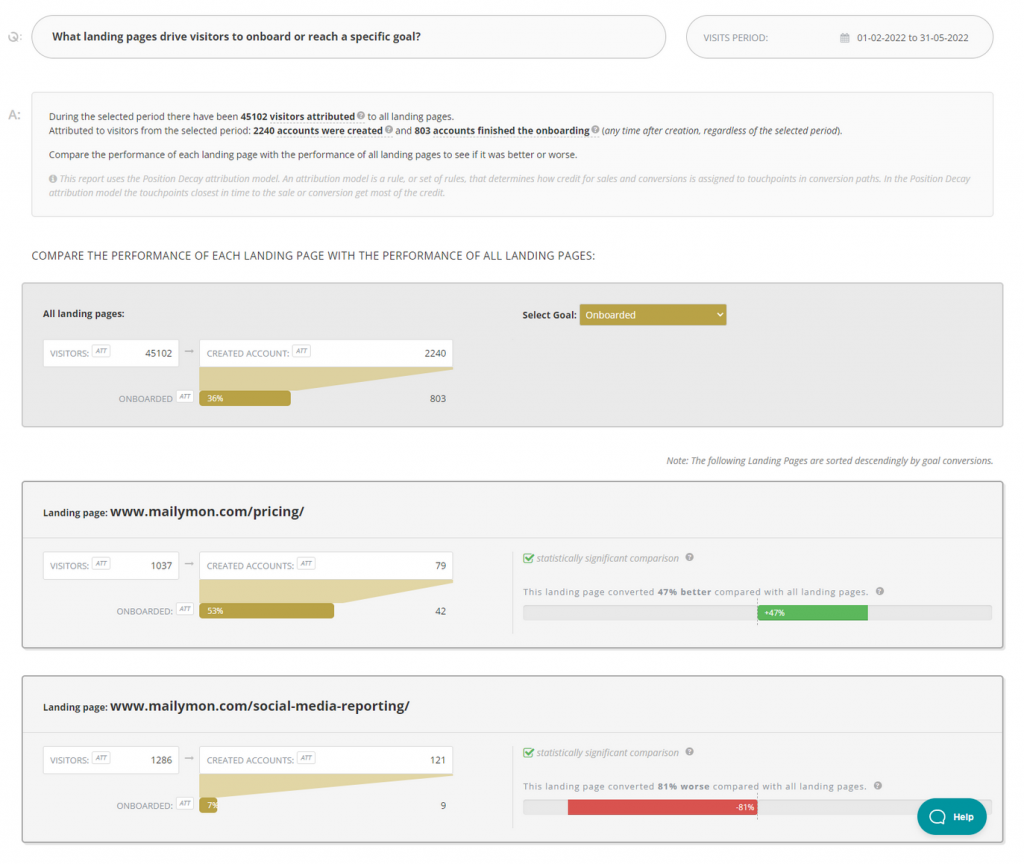
What insight(s) you’ll get: Comparison of the performance of all your landing pages | the report automatically highlights the pages that are statistically significantly better.
Analyze the impact of your A/B tests on the quality of your acquired customers
When you run an A/B test on your website to test different messaging, different offers, or different CTAs, you’re more often than not just testing the conversion rate or click through rate of those pages and comparing them against each other.
How about going further down the customer journey, and understanding the impact of your messaging or offers not only on acquisition but also on onboarding, retention and engagement.
How does it work? You mark the variant that is shown to users as an account property within the InnerTrends product analytics platform. You’re then able to segment any report inside InnerTrends including onboarding, retention and engagement reports based on the variant that drove people to sign up.
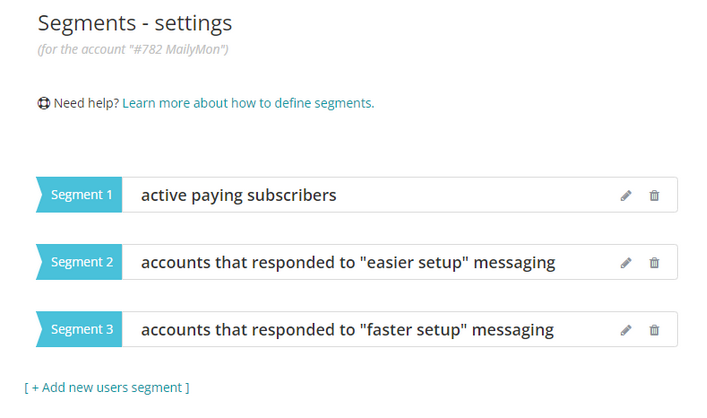
Outcome: You can see the impact a different message has on the customer journey.
Integrations: InnerTrends integrates with all the major AB testing platforms for automatic tracking: Google Optimize, Visual Website Optimizer, Optimizely, Convert, etc.
How to find interview candidates within your user base
When you want to perform qualitative research and decide your best bet is customer interviews, how do you know which customers to pick?
With InnerTrends pre-built product analytics reports, you can get a list of accounts that fulfill certain criteria – for example: have high engagement and have finalized onboarding within the last three months.
How does it work? You mark the variant that is shown to users as an account property within the InnerTrends product analytics platform. You’re then able to segment any report inside InnerTrends including onboarding, retention and engagement reports based on the variant that drove people to sign up.
These accounts are happy, get lots of value with your product, and are very likely to answer your question: “What made you decide to use our product?”, as they recently signed up.
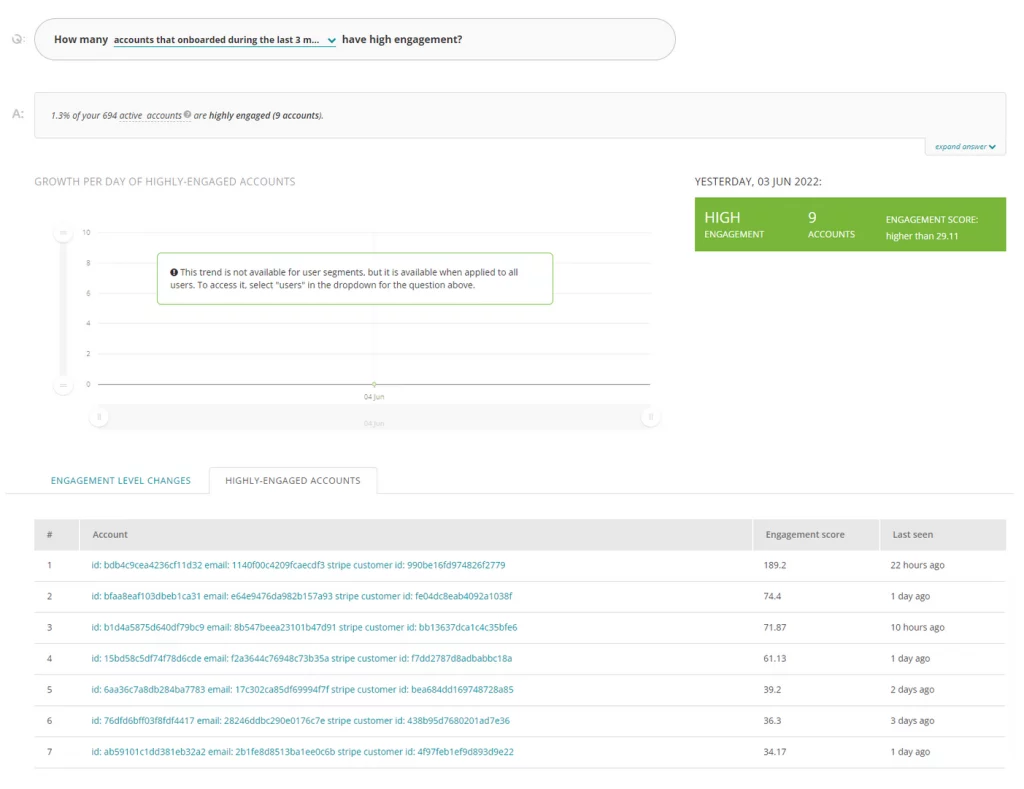
Wrap-up
Hopefully, this guide clarified how you could find and improve your product-market fit faster using data insights derived from product analytics.
The critical point is that getting to your product-market fit is gradual and iterative.
As the market evolves, so does the “fit.” You need to constantly monitor how well your product serves your chosen market segments and what changes you need to make in your product, messaging, or channels you communicate on.
Keep asking questions and looking at your data; you’ll know if you are on the right path.